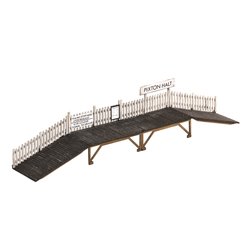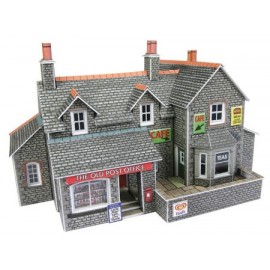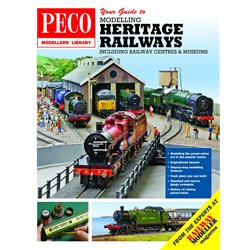This really depends on what it is you plan to glue, most things can be glued straight from the bottle, but this will...
No products
Product successfully added to your shopping cart
There are 0 items in your cart. There is 1 item in your cart.
Search Tips
Christmas and New Year
We are dispatching orders every weekday apart from Christmas Day, Boxing Day and New Year's Day.
If you order is time critical, select next day delivery at checkout.
The shop in Sandown is closed from 25th December, reopening on 30th December.
What is a boxfile layout?
A boxfile layout is a creative and compact way to build a model railway within the confines of a standard box file, which is typically a sturdy cardboard or plastic container used for storing documents. This concept has gained popularity among enthusiasts who are short on space or want to create portable layouts.
Key Features of a Boxfile Layout
Compact Size:
- Dimensions: A standard box file typically measures around 35cm x 25cm x 8cm (13.8” x 9.8” x 3.1”), making it ideal for a small-scale layout.
- Portability: Due to its compact size, a boxfile layout can easily be stored on a shelf, transported to exhibitions, or moved between different locations.
Scale and Gauge:
- Scale: Boxfile layouts often utilise smaller scales like N gauge (1:148) or Z gauge (1:220) to make the most of the limited space. Some modellers also use T gauge (1:450), which allows for more detail in an even smaller area.
- Gauge: In some cases, OO gauge (1:76) or HO gauge (1:87) are used, but these require more creative use of space to fit into the constraints of a box file.
Track Plan:
- Simple Track Designs: Due to the limited space, track plans in boxfile layouts are often simple, featuring a small oval, a figure-of-eight, or a shunting puzzle like an Inglenook Sidings or Timesaver.
- Innovative Layouts: Modellers often use clever design techniques, such as vertical layers or fold-out sections, to maximise the available track and scenery within the boxfile.
Scenery and Detailing:
- Realistic Scenes: Despite the small size, modellers strive to create realistic scenes with detailed scenery, buildings, and landscapes. This often involves using fine-scale modelling techniques to add depth and authenticity.
- Creative Themes: Common themes include industrial settings, rural landscapes, or urban environments, often inspired by specific UK locations or historical periods.
Operation:
- Functional Layouts: Many boxfile layouts are fully operational, allowing for realistic train movements, shunting operations, and other railway activities.
- DCC or Analogue: Some enthusiasts incorporate Digital Command Control (DCC) systems for more sophisticated control, though traditional analogue controls are also widely used due to their simplicity.
Customisation and Innovation:
- Personal Projects: Modellers often take on boxfile layouts as personal projects, experimenting with different construction techniques, materials, and themes.
- Exhibitions and Competitions: Boxfile layouts are popular in model railway exhibitions and competitions, where their compact size and creativity are appreciated.
Benefits of Boxfile Layouts
- Space-Saving: Ideal for those with limited space, as the layout can be easily stored and displayed on a desk or shelf.
- Cost-Effective: Generally more affordable than larger layouts, as they require fewer materials and components.
- Portable: Easy to transport, making them perfect for exhibitions, clubs, or simply showing off to friends and family.
- Creative Outlet: Encourages creativity and problem-solving, as modellers must work within the constraints of the box file to create a functional and appealing layout.
Popular Boxfile Layout Ideas
Here are some popular ideas and inspirations for boxfile layouts:
- Industrial Sidings: An industrial-themed layout with factories, warehouses, and shunting operations.
- Rural Halt: A countryside scene with a small station, farm buildings, and rolling hills.
- Urban Scene: A cityscape featuring streets, shops, and residential areas, perhaps with trams or buses.
- Coastal Village: A seaside setting with fishing boats, piers, and a quaint village.
- Heritage Railway: A preserved railway line with vintage trains and restored stations.
Getting Started with a Boxfile Layout
If you're interested in creating your own boxfile layout, here are some steps to get started:
Choose Your Theme and Scale:
- Decide on a theme that interests you, such as a specific era or location.
- Select the appropriate scale for your chosen theme, keeping in mind the constraints of the box file.
Plan Your Track Layout:
- Sketch out a simple track plan that fits within the boxfile dimensions.
- Consider incorporating points (switches) for added operational interest.
Gather Materials:
- Obtain a box file, track sections, locomotives, rolling stock, and scenery materials.
- Ensure all components are compatible with your chosen scale.
Construct the Layout:
- Assemble the track and scenery within the box file, paying attention to detail and realism.
- Test the track for smooth operation and adjust as necessary.
Add Scenic Details:
- Enhance the layout with buildings, figures, vehicles, and other scenic elements.
- Use paints, foliage, and textures to create a lifelike environment.
Operate and Enjoy:
- Once complete, operate your boxfile layout and enjoy the satisfaction of a functional and aesthetically pleasing model railway.
Conclusion
Boxfile layouts offer a unique and rewarding modelling experience, allowing enthusiasts to enjoy the hobby without needing a large dedicated space. They combine creativity, engineering, and artistry within a compact, portable format that can be shared and admired by others. Whether you’re a seasoned modeller or a newcomer to the hobby, a boxfile layout provides an excellent opportunity to explore the world of model railways.
Click here to receive the tips weekly in your mailbox. You can unsubscribe at any time.










